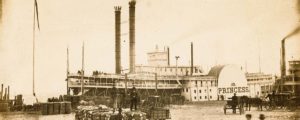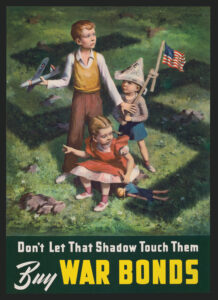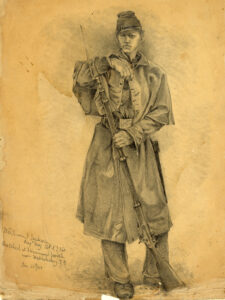In 1861, Erin’s sons and daughters embraced the Union war effort; but by 1863 their disgust with the draft and emancipation caused them to riot in New York.
New York attorney George Templeton Strong remembered the morning of July 13, 1863, as “deadly muggy” with “a muddy sky and lifeless air.” Through this heat he observed a growing crowd of “gaunt-looking savage men and women and even little children armed with brickbats, stones, pokers, shovels and tongs, coal scuttles, and even tin pans and bits of iron.”
As members of New York’s impoverished wards marched into more affluent neighborhoods, some citizens thought they were witnessing the beginning of a parade, or, as one woman mused, an immigrant festival. July was the common marching season for Irish Protestants and Catholics, as their religious animosities flared on the anniversary of the Protestants’ victory at the 1690 Battle of the Boyne. Such tension had led to violence before the Civil War, and would again. But this July was different, as were the motives of the marchers. For one horrifying week, these New York laborers, dominated by unskilled Irish-Catholic workers, would terrify the city during one of the worst riots in American history.
The New York City draft riots are usually recalled as a violent clash between rich and poor, and as a demonstration of the tensions between African Americans and their impoverished white neighbors—particularly Irish-Catholic immigrants. This is partially accurate, but overlooks a key to the rage that fueled the riots.
In the second year of the war, the North had few victories to celebrate. Irish-Catholic New Yorkers paid close attention to units that represented their traditions, including Thomas Francis Meagher’s Irish Brigade in the Army of the Potomac, and there had been little to cheer. This was starkly different from the previous fall—while they shared their part of the Union defeat at Bull Run, Irishmen took pride in how well the 69th New York State Militia fought under its colonel, Michael Corcoran. They boasted as well of how quickly Meagher stepped forward to replace the captured Corcoran and recruited an entire brigade of Irish-Catholics.
Well, almost all Irish-Catholic. A regiment of Protestants slipped in when the 29th Massachusetts joined the 63rd, 69th, and 88th New York, but the men joked about their old animosities amid the patriotic fervor of 1861. These sentiments echoed in Boston, where Harvard University conferred an honorary doctorate of divinity on Archbishop John Fitzpatrick. In nearby Connecticut, a native-born ladies’ society in New Haven sewed an Irish harp to the state flag they presented to the Irish 9th Connecticut, which the local paper insisted was led by a colonel of “superior accomplishments and genius” and supported by a major who was also a “profound scholar, a polished gentleman, and distinguished lawyer.” Such accolades from native-born Protestants had been unheard of amid the outspoken anti-immigrant and anti-Catholic nativism of the previous decade.
This camraderie continued into 1862, but was fading rapidly by fall. In September, Confederate General Robert E. Lee’s Army of Northern Virginia clashed with General George B. McClellan’s Army of the Potomac in the rolling fields and woods outside Sharpsburg, Md. Meagher watched in horror as Confederate fire “literally cut lanes through our approaching line” as the Irishmen closed on the Sunken Road during the Battle of Antietam. By the time their advance faltered and the men fell back, the brigade had suffered horribly—especially the 63rd and 69th New York, with 60 percent casualties each.
McClellan called the battle a great victory and insisted “the Irish Brigade sustained its well-earned reputation” that day, but the lists of killed, wounded and missing that appeared in the papers revealed the cost. Five days later another shock ran through Irish communities when President Lincoln announced the Emancipation Proclamation.
The proclamation provoked an outcry throughout the North, but Irish Catholics were particularly enraged. The New York Weekly Day Book, a strongly anti-Lincoln, anti-African American press, insisted emancipation “degraded” Irish laborers “to a level with Negroes,” playing on historic prejudices in the Irish community. The New York Irish-American similarly accused the Lincoln administration of suffering from “Negrophilism” and reminded Irish Catholics of “the irredeemable malignity of the Abolition hatred of [the Irish] race.” The Catholic leader of New York, Irish-born Archbishop John Hughes, warned that “we Catholics, and a vast majority of our brave troops in the field, have not the slightest idea of carrying on a war that costs so much blood and treasure just to gratify a clique of Abolitionists.”
President Lincoln compounded this fury when he relieved George McClellan of his command. From a historical perspective, it was a wise decision. For Irishmen and many other Union troops, however, it was an outrage. To them, McClellan was a general who refused to waste lives with unnecessary attacks and who addressed the needs of his men. Several Irish Brigade officers resigned in protest, but Meagher refused to accept their resignations. He did, however, write a letter for publication in the New York World insisting, “Ah! If the gentlemen of the White House could have seen what I saw this morning—could have heard the cheers from those 100,000 soldiers which rent the air and deadened the artillery itself as the parting salute was fired—they would have felt that a mistake or crime has been committed by them, which the Army of the Union will never forgive.”
Irish New Yorkers, and Democrats across the North, registered their frustration in the congressional elections that fall. Democrats ousted Republicans from 35 seats, installed new governors in New York and New Jersey and enjoyed victories in Indiana, Illinois, Ohio and Pennsylvania. Democratic leaders declared the results evidence the nation had “rejected emancipation, arbitrary arrest, and military incompetency.”
Amid these broiling tensions came news of a disastrous Federal defeat at the Battle of Fredericksburg, fought December 13 in Virginia. Major John Dwyer of the 63rd New York observed that “the dead were piled in heaps” all over Marye’s Heights, while Father William Corby, the chaplain of the 88th New York, reported “the place into which Meagher’s brigade was sent was simply a slaughter-pen.”
In New York, this news dominated Irish papers. Two days after Christmas, the Irish-American published a letter Captain William J. Nagle of the 88th New York wrote to his father the day after the battle. “Irish blood and Irish bone cover that terrible field to-day,” Nagle wrote. “The whole-souled enthusiasm with which General McClellan inspired his army is wanting—his great scientific engineering skill is missing— his humane care for the lives of his men is disregarded. We are slaughtered like sheep, and no result but defeat.”
This bitter mood swept Irish New Yorkers into 1863 and seemed to hover. In January, St. Patrick’s Cathedral held a high mass for the dead of the Irish Brigade. The sorrow echoed in camp as an Irish soldier lamented, “All is dark, and lonesome, and sorrow hangs as a shroud over us all.”
Compounding this gloom was the Conscription Act of 1863. It was an unpopular bill throughout the North, where Irish Catholics had not been alone in their loss of beloved soldiers nor in their disappointment with the government. But few other groups in the Union would sustain the frustration that permeated Irish-Catholic neighborhoods by the early spring of 1863. While most Irish Catholics stood firm in their faith to Union, they never endorsed emancipation nor demonstrated a renewed faith in their president in 1864, when most of their northern neighbors and fellow soldiers re-elected Lincoln in a landslide. Conscription proved another point on which Irish support for the war would wane.
Drafts had already left a bad taste in Northern mouths. Congress passed the Militia Act in 1862, allowing states to institute a draft if they failed to meet recruiting quotas with volunteers. It resulted in everything from committee appeals to full-fledged riots as citizens and immigrants resisted.
But while native-born Americans opposed the law, they resented the idea that immigrants would protest, too. Nativist suspicions resurfaced as citizens interpreted immigrant protest as selfish ingratitude. In Wisconsin, the Milwaukee Daily News insisted that immigrants “are so absorbed in the contemplation of the duties now to be performed that they have forgotten the rights they have for so many years enjoyed.” It was in Wisconsin that some of the earliest draft riots occurred—particularly among the German-American populations—the previous fall; but general resistance to Union military service was also building in the mining regions of eastern Pennsylvania, which included significant Irish-Catholic communities, and in towns across the Midwest as well as larger cities like Boston and New York.
The Pilot, the archdiocesan newspaper in Boston, had reminded Catholic immigrants that unnaturalized citizens could not be drafted. But the editors encouraged military-age males of their “moral obligation to enlist in the army of the Union” or find some way to support the cause. Similarly, New York Irish Catholics heard the instructions of Archbishop Hughes, who saw state drafts and the looming federal draft as a way to ensure that “every man, rich and poor, will have to take his share” of the fight.
But these sentiments were from the previous summer, before Antietam and the loss of McClellan, before Fredericksburg, and most significantly, before emancipation. As Congress prepared to pass the Enrollment Act in the spring of 1863, Irishmen learned that any immigrant who had declared his intent to become a citizen could now be drafted unless he left the country within 65 days. The Pilot complained that most immigrants “cannot get away in that time” and reminded its readers that “many of them are here, too, under the advice of Secretary [of State William] Seward,” who had promised the British government the United States was not encouraging immigration to fill its armies. Seward had pledged that “none but citizens are liable to military duty in [the United States].” It had all been, declared the Pilot, “a miserable Yankee trick to entice over here ‘food for powder.’”
Just as Irish-Catholic suspicions of the government seemed at their highest, scandalous rumors surfaced in their communities about the Lincoln administration’s treatment of Meagher and the Irish Brigade. Meagher had spent much of January and February in New York attempting unsuccess–fully to recruit replacements for his dwindling command, and the editors of the Irish-American warned Meagher that his efforts would work only “if men can yet be found to volunteer in a war—the conduct of which reflects anything but credit on those who have undertaken its management.”
But then Meagher publicly chastised the Lincoln administration’s treatment of his brigade. He complained that the government unfairly denied his appeals for leave for his New Yorkers. Meagher was certain that having the men in the city would bolster his recruiting efforts, and the soldiers’ families desperately wanted the men home.
What the general public did not realize was that military policy had changed. The Army was denying requests in all theaters, especially on the eve of the campaign season of 1863. Secretary of War Edwin M. Stanton and General-in-Chief of the Armies Henry W. Halleck had agreed that their previous practice, which resulted in as many as a third of the Northern armies being away from their commands at one time, had to stop. The trouble was they never clearly explained this to Meagher, which proved a dangerous decision. This was “Meagher of the Sword,” the Irish nationalist orator who had always been a far better speaker and recruiter than field commander, and he wielded his talents that spring.
The Irish-American picked up the story, complaining of “favoritism” and “unjust discrimination” against the brigade, while Meagher claimed he was requesting no more “than that which has been conceded to other commands, exhibiting equal labors, equal sacrifices, and equal decimination.”
These actions did not improve Meagher’s reputation with the Lincoln administration, where frustration with the general mounted. Several times that spring, Meagher had knowingly violated the dates of his leave from the Army and his average—even poor—performance on the battlefield, combined with his active encouragement of protest in Irish communities, did not endear him to Stanton or Halleck. Then in mid-February, Meagher breached the chain of command, taking his complaints straight to the president.
Halleck had already warned Stanton against accepting applications for leave “supported by pressing solicitations of high officers of the Government.” Halleck was weary of political generals whose commands had little to do with skill and more with their influence of voters. “It seems but little better than murder to give important commands” to such men, Halleck insisted. Lincoln agreed, complaining to Halleck that for every politically influenced promotion, he had to remove a fighting general who could win the war. While the administration had a reasonable case, it did not appear so in the Irish-Catholic neighborhoods of New York.
On May 8, Meagher wrote to John Hancock, an assistant adjutant general in the War Department. Meagher reminded him of the brigade’s losses at Malvern Hill, Antietam, Fredericksburg and Chancellorsville. “The depression caused by this ungenerous and inconsiderate treatment of a gallant remnant of the Brigade that had never once failed to do its duty most liberally and heroically, almost unfitted me to remain in command,” Meagher argued. Still, he insisted, he preferred “to remain in the companionship and charge of such men” despite the fact that he knew “it was to a sacrifice rather than to a victory we were going.”
But “to do so any longer would be to perpetuate a public deception, in which the hard-won honors of good soldiers, and in them the military reputation of a brave old race would inevitably be involved and compromised.”
The War Department’s response was brief: “Your resignation has been accepted by the President of the United States, to take effect this day.”
New York Irish were outraged. Support for Meagher’s recruiting efforts had faded, but their sense that he and their fellow Irishmen were cast aside by the Lincoln administration was too much.The Irish-American had already been complaining that “If the Brigade were not so markedly and distinctively Irish, they would not have been treated with the positive injustice and neglect to which they have been exposed.”
Now the paper published another letter from Captain William Nagle of the 88th New York, which captured perfectly the mood in both the camp and among the Irish-American’s readers at home. “Am I not right in saying,” Nagle asked, “that in any other country the brigade which had fought and suffered as this has would be gratefully and proudly cherished, its ranks kept full, its deeds of heroism acknowledged and rewarded? We asked neither reward nor favor, only what was right—just to the government, and for the advancement and good of the cause in which we had staked life and reputation. It was denied us, and the Irish Brigade is blotted out of the army of the Union.”
In Boston, the editors of the Pilot raged, “We are an emigrant race; we did not cause this war; vast numbers of our people have perished in it….[T]he Irish spirit for the war is dead! Absolutely dead!”Then just weeks before the draft they warned, “The Irish will never forgive this extreme want of decorum. It will remain in their memory with national bitterness as the deaths of their warriors will with national regret. Such sentiments will have their effect.”
Six weeks later, New York erupted in a storm of violence. Irish-Catholic laborers’ rage was definitely fueled by racism and socioeconomic insecurities. But it was also the result of tensions that rippled back from the battlefields and from Washington. The overwhelming cost of the war combined with the popular sense among Irishmen that they had volunteered to fight for Union, not emancipation.
As the drum turned in the New York draft office on Saturday, July 11, an uneasy stillness hung over the city. By Monday the storm rolled in as workers and their families marched out of their neighborhoods to strike down any symbol of Lincoln and Republicanism. They targeted African Americans, abolitionists, and anyone they might hold responsible for their perceived injustices. While it included large numbers of Irish Catholics, the mob also contained Germans and other immigrants as well as skilled laborers.
But there were Irish Catholics on both sides of this fight. The Irish Brigade’s own Colonel Robert Nugent, home recovering from a wound received at Fredericksburg, was in charge of the draft in the city. Nugent saw the draft as law and the war as necessary, and he had little patience for rioters, who destroyed his home and would likely have killed Nugent had they captured him. They nearly killed police Superintendent John A. Kennedy.
The mobs looted and burned large sections of New York, including the Colored Orphans Asylum, whose residents barely escaped. Fires swept across the city, in part because Irish-Catholic fire crews participated in the violence. African Americans and any symbol of affluence, which included abolitionists and Republicans, caught the rioters rage. By Tuesday, most of the skilled laborers and fire companies had returned to work, but unskilled workers, dominated by Irish Catholics, continued their resistance for two more days.
There were exceptions. On Tuesday morning Colonel Henry O’Brien ordered his 11th New York Volunteers to support the police by firing into the raging crowds. Reports raced through neighborhoods that afternoon that O’Brien’s order had resulted in the deaths of at least one woman and child, if not more. Rioters found his home and destroyed it, and then captured O’Brien when he returned to assess the damage. Over the next six hours, the mob beat the Union officer with fists and clubs, while women took turns pounding his face beyond recognition. They offered similar abuse to anyone—including fellow Irish Catholics like O’Brien— who appeared to support the Lincoln administration, its policies and anyone enforcing them.
By Thursday, Federal troops arrived to help crush the violence, and a smoldering, troubled peace surfaced by Friday. At the front, some Irish Brigade soldiers were horrified by the violence—including Sergeant Peter Welsh of the 28th Massachusetts, who insisted the draft was the only way to fairly share the burden of fighting. He suggested using canister and grape against the “skulking blowers at home” who resist their duty. “God help the Irish,” he prayed. “They are to[o] easily led into such snares which give their enemys [sic] an opportunity to malighn [sic] and abuse them.”
But sentiments at home, at least within the Irish-Catholic community, revealed regret for the violence but an insistence that they were not to blame. The New York Irish-American claimed the Lincoln administration knew “the danger they were risking, and the outbreak of popular resentment and opposition which the obnoxious character of the law would be certain to provoke.”They had “heeded neither advice nor warning; and the deplorable results…are all that their disregard of the plainest dictates of common sense has produced.” Archbishop Hughes agreed. While he faulted the rioters for their violence, he attacked those who blamed the Irish-Catholic community. He challenged abolitionist and New York Tribune editor Horace Greeley’s claim that all those arrested were Irish and that their community certainly must be blamed. Hughes insisted that if only Irishmen were arrested, it was further proof they were “innocuous victims of our municipal laws” and the favorite targets of nativists.
To native-born New Yorkers, the rioters confirmed all their prejudices about Irishmen. “‘Resistance to the draft’ was the flimsiest of veils to cover the wholesale plundering which characterized the operations of the day,” the Times declared, reminding readers how much the poor could benefit by earning the $300 bounty for volunteering. To Irishmen, however, that impossible sum revealed lasting prejudices.
Disgusted by the violence and what they saw as the cause of it, the editors of the Irish-American insisted, “It was supposed that the outbreak of the rebellion, and the patriotism evinced on all sides by Irish-Americans, would put an end to the invidious attacks of [the New York Tribune and the Chicago Tribune], which, like Harper’s Weekly, were ever ready to denounce us as ‘nuisances.’ But such moderation could not long endure. The moment the Abolition faction began to take breath after the first shock of the secession movement had passed, and the struggle for political preeminence recommenced, the old spirit soon displayed itself and at every check the Radicals experienced, ‘the Irish’ came in for unsparing denunciation for their faithful adherence to the old Democratic faith and traditions of the nation, to which none have been truer than they.”
In five days of rioting, men and women—most of them Irish Catholics—looted and burned an African-American orphanage, destroyed millions of dollars worth of property and contributed to the deaths, directly or indirectly, of well over 100 people.
Eventually the Irish-American community stopped trying to defend what happened. If something positive came from that week of horror, it was the realization that reasonable complaints had to be made in a far more reasoned manner. Over the next two years, New York Democrats raised enough money to buy the exemption of nearly every drafted man who did not wish to serve. They also clarified that the brutality of the July riots could not—would not—define their communities. The New York Irish became increasingly skilled at launching their protests with ballots rather than fists. And they would insist that if Americans chose to remember their horrific behavior in that hot July of 1863, they must also remember the sacrifices of thousands of loyal Irish-Catholic soldiers to the preservation of the Union.
Susannah Ural Bruce, Ph.D., is associate professor of history at Sam Houston State University. This article is based on her book, The Harp and the Eagle: Irish-American Volunteers in the Union Army, 1861-1865 (NYU Press, 2006).
Originally published in the March 2009 issue of America’s Civil War. To subscribe, click here.




